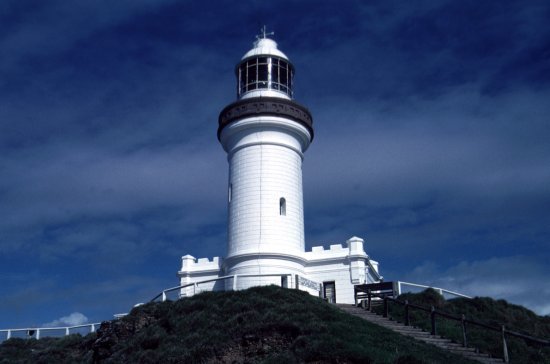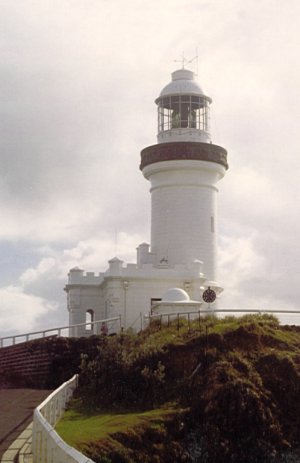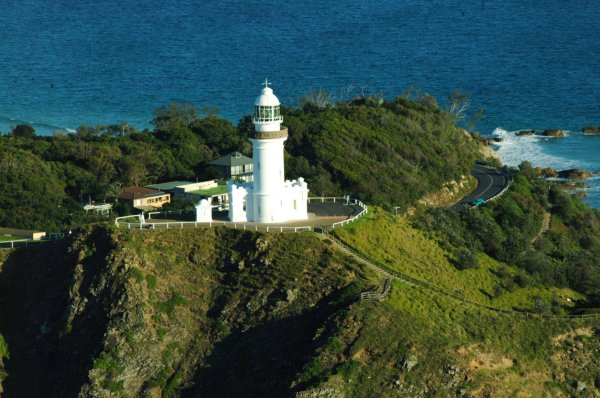Cape Byron Lighthouse
The Cape Byron Lighthouse is Australia’s most easterly light being situated on the most easterly point of the mainland. It is also Australia’s most powerful Lighthouse.
History
Constructed of prefabricated concrete blocks in 1901, the Cape Byron Lighthouse stands on the most easterly point of the Australian mainland and is Australia’s most easterly lighthouse.
Built by James Barnet’s successor, Charles Harding. James Barnet, the New South Wales colonial architect, was renown for his towers having large ornate balconies and are easily distinguished.
The first-order optical lens, which weighs 8 tons, was made by the French company, Societe des Establishment, Henry Lepaute, Paris. It contains 760 pieces of highly polished prismatic glass.
The original concentric six wick burner was 145,000 cd. This was replaced in 1922 by a vapourised kerosene mantle burner which gave an illumination of 500,000 cd.
In 1956, the light became Australia’s most powerful, at 2,200,00 cd when it was converted to mains electricity. At the same time the clock mechanism was replaced by an electric motor.
An auxiliary fixed red light is also exhibited from the tower to cover Juan and Julian Rocks to the north east.
continued below …
© All images are copyright of their respective photographers and are not to be used without permission.
| Title | Address | Description |
|---|---|---|
Fingal Head | 1B Lighthouse Parade, Fingal Head NSW 2487, Australia | Fingal Head |
Cape Byron | Cape Byron Walking Track, Byron Bay NSW 2481, Australia | Cape Byron |
Richmond River | 6 Harbourview St, East Ballina NSW 2478, Australia | Richmond River |
continued from above …
A great banquet was arranged for the opening in 1901 and many dignitaries, including the NSW Premier of the day John See, were invited. However due to adverse weather conditions the premiers ship was delayed until the following day and the banquet was held without him. The opening by the Premier took place a day late on the Sunday.
It is interesting to note that Cape Byron was named by Captain Cook after John Byron, grandfather of the famous poet.
Preservation Issues
The ownership of the reserve was handed over to the Parks and Wildlife Service of New South Wales in 1998. The reserve was already under a lease to the Cape Byron Headland Reserve Trust who maintain and secure the site and buildings. It is currently used as a base for whale watching.
Keepers
We need your help in compiling a list of keepers for this lighthouse. If you have any information then send it to keeper@lighthouses.org.au.
Please include this lighthouse’s name, the keepers full name and what years they were keepers. Also include the same information for any other lights they were on.
Technical Details
| Exhibited | 1901 |
| Status | Active |
| Main Optic | 920mm 2 panel on mercury float. Societe des Establishment, Henry Lepaute, Paris |
| Aux Optic | Tideland ML300, Red Lens Fitted |
| Automated | 1989 |
| Demanned | 1989 |
| Location | Lat. 028° 38.4' S. Long. 153° 38.1' E |
| Construction | Concrete Blocks |
| Height | 22m |
| Elevation | 118m |
| Range | 27 NM |
| Character | Main: Flashing White (1) 15 secs Aux: Fixed Red 148-189 deg |
| Intensity | Main: 2,060,000 cd Aux: 600 cd |
| Light Source | Main: Sealite SL324 LED array Aux: 12 volt 35 Watt halogen |
| Power Source | Mains Power, battery backup. |
| Operator | AMSA |
| Custodian | AMSA |
| Notes | Original Chance Bros 4th order aux optic on display in base of tower |
| Current as of | May 2018 |
Access
Cape Byron Lighthouse is 2km east of the Byron Bay town centre. Parking is available at the lighthouse but spaces are limited. There is a park entry fee for vehicles
Site Access
There is a park Entry Fee for vehicles
Tours
A private tour option is available with prior booking.
A virtual tour is available from Google Street View Trekker
Accommodation
The heritage-listed Assistant Lighthouse Keepers’ Cottages at Byron Bay is available for a weekend getaway or longer holiday.
Museum
The Maritime Museum in the former Lighthouse Keeper’s office at the base of the lighthouse is open 10am to 4pm daily. The Museum also displays images and artefacts from the days when Byron Bay was a venue for whale hunting rather than whale watching. A team of dedicated volunteers staff the museum 7 days a week.
Friends Group
Looking for volunteer work with a view? If you’ve got a minimum of 3 hours a week to spare, come and be part of a friendly team at Cape Byron. Lead guided tours of the museum and lighthouse and share the area’s fascinating maritime history with visitors.
https://www.nationalparks.nsw.gov.au/things-to-do/volunteer-activities/cape-byron-lighthouse-friends
Cape Byron Lighthouse Friends and Volunteers Facebook page
Sources
- Cape Byron – Roxford Bree
- 4Cs Enterprises for Photographs
- Annette Flotwell for Photograph
- Brian Lord for Photographs
- Cyril Curtain for Photographs
- Erik for Photographs
- Winsome Bonham for Photographs
- AMSA Brochure
- Brian Lord
- From Dusk Till Dawn by Gordon Reid







